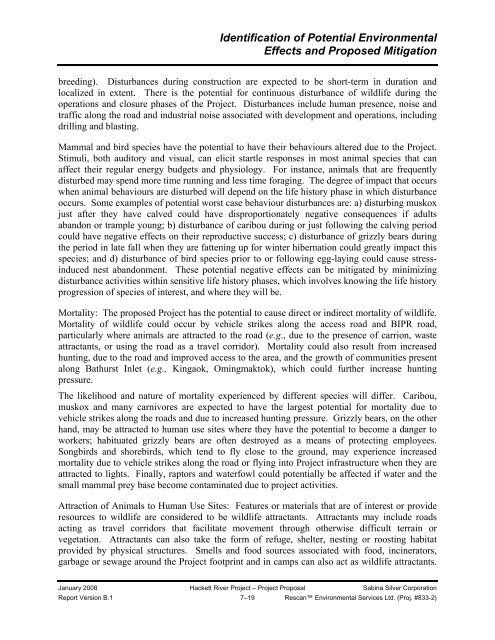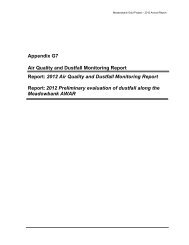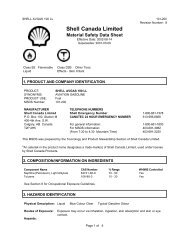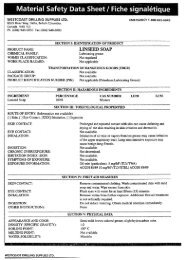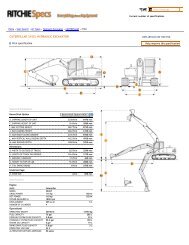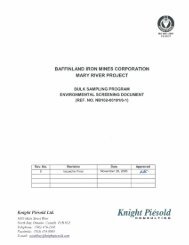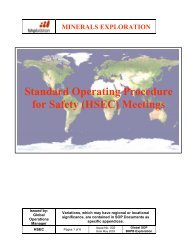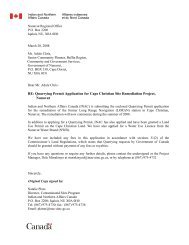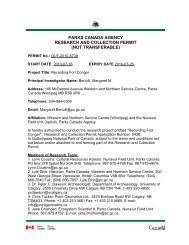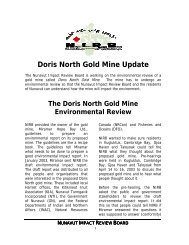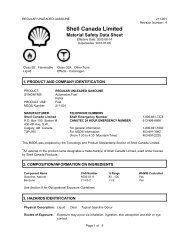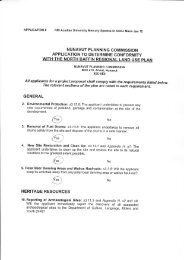080121-08MN006-Sabina Hackett River Project Proposal ... - NIRB
080121-08MN006-Sabina Hackett River Project Proposal ... - NIRB
080121-08MN006-Sabina Hackett River Project Proposal ... - NIRB
You also want an ePaper? Increase the reach of your titles
YUMPU automatically turns print PDFs into web optimized ePapers that Google loves.
Identification of Potential EnvironmentalEffects and Proposed Mitigationbreeding). Disturbances during construction are expected to be short-term in duration andlocalized in extent. There is the potential for continuous disturbance of wildlife during theoperations and closure phases of the <strong>Project</strong>. Disturbances include human presence, noise andtraffic along the road and industrial noise associated with development and operations, includingdrilling and blasting.Mammal and bird species have the potential to have their behaviours altered due to the <strong>Project</strong>.Stimuli, both auditory and visual, can elicit startle responses in most animal species that canaffect their regular energy budgets and physiology. For instance, animals that are frequentlydisturbed may spend more time running and less time foraging. The degree of impact that occurswhen animal behaviours are disturbed will depend on the life history phase in which disturbanceoccurs. Some examples of potential worst case behaviour disturbances are: a) disturbing muskoxjust after they have calved could have disproportionately negative consequences if adultsabandon or trample young; b) disturbance of caribou during or just following the calving periodcould have negative effects on their reproductive success; c) disturbance of grizzly bears duringthe period in late fall when they are fattening up for winter hibernation could greatly impact thisspecies; and d) disturbance of bird species prior to or following egg-laying could cause stressinducednest abandonment. These potential negative effects can be mitigated by minimizingdisturbance activities within sensitive life history phases, which involves knowing the life historyprogression of species of interest, and where they will be.Mortality: The proposed <strong>Project</strong> has the potential to cause direct or indirect mortality of wildlife.Mortality of wildlife could occur by vehicle strikes along the access road and BIPR road,particularly where animals are attracted to the road (e.g., due to the presence of carrion, wasteattractants, or using the road as a travel corridor). Mortality could also result from increasedhunting, due to the road and improved access to the area, and the growth of communities presentalong Bathurst Inlet (e.g., Kingaok, Omingmaktok), which could further increase huntingpressure.The likelihood and nature of mortality experienced by different species will differ. Caribou,muskox and many carnivores are expected to have the largest potential for mortality due tovehicle strikes along the roads and due to increased hunting pressure. Grizzly bears, on the otherhand, may be attracted to human use sites where they have the potential to become a danger toworkers; habituated grizzly bears are often destroyed as a means of protecting employees.Songbirds and shorebirds, which tend to fly close to the ground, may experience increasedmortality due to vehicle strikes along the road or flying into <strong>Project</strong> infrastructure when they areattracted to lights. Finally, raptors and waterfowl could potentially be affected if water and thesmall mammal prey base become contaminated due to project activities.Attraction of Animals to Human Use Sites: Features or materials that are of interest or provideresources to wildlife are considered to be wildlife attractants. Attractants may include roadsacting as travel corridors that facilitate movement through otherwise difficult terrain orvegetation. Attractants can also take the form of refuge, shelter, nesting or roosting habitatprovided by physical structures. Smells and food sources associated with food, incinerators,garbage or sewage around the <strong>Project</strong> footprint and in camps can also act as wildlife attractants.January 2008 <strong>Hackett</strong> <strong>River</strong> <strong>Project</strong> – <strong>Project</strong> <strong>Proposal</strong> <strong>Sabina</strong> Silver CorporationReport Version B.1 7–19 Rescan Environmental Services Ltd. (Proj. #833-2)


